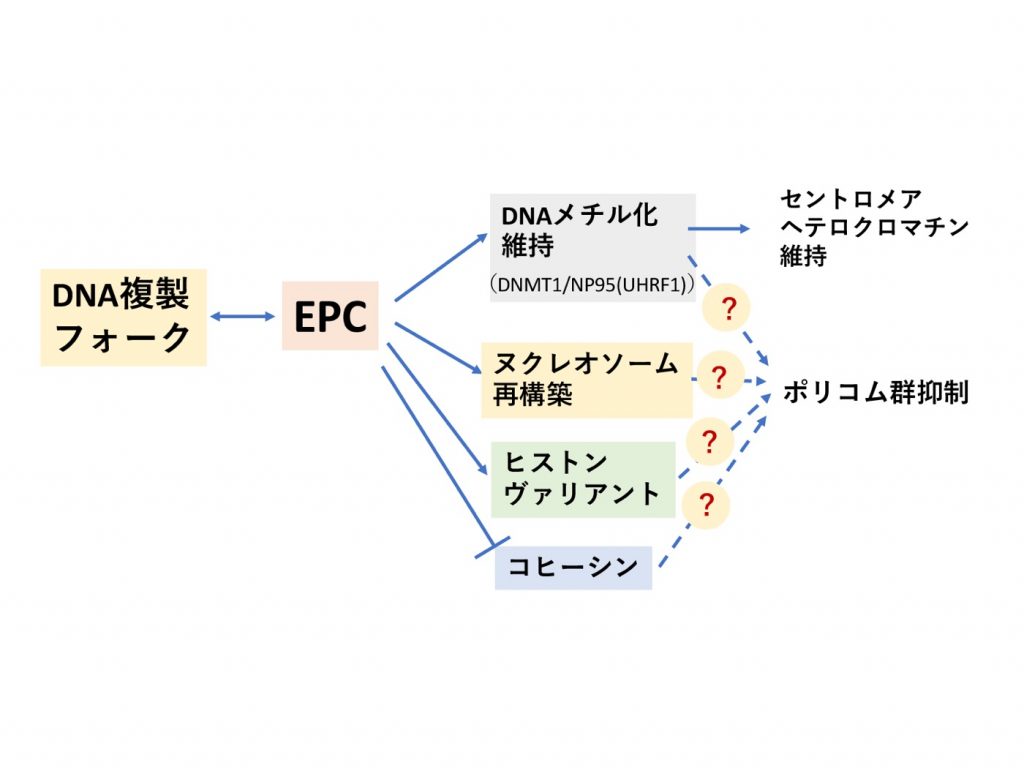ポリコム群による抑制ドメインの複製機構の解明
研究代表者
[sc name=”Koseki”]
研究分担者
[sc name=”Endo” ]
研究内容
ポリコム群による抑制が、分裂後の細胞へ伝達されるメカニズムは今も大きな疑問として残されている。ポリコム群のひとつとして遺伝学的に同定されてきたEPC が、DNA 複製メカニズムとカップルし、DNA メチル化維持、複製後ヌクレオソーム再構築メカニズム、ヒトんヴァリアントのローディング、コヒーシンとリンクすることを見出したことは、この問に答えるために重要な入り口を与えた(図6)。本研究の中では、①DNA メチル化維持メカニズムとポリコム群の再構築過程での機能的リンク、及び、②ヌクレオソーム再構築メカニズム、ヴァリアントヒストン、及び、ポリコム群再構築過程の間の機能的なリンクの2つの問題にチャレンジする。

主な論文
研究代表者:古関明彦
- Isono, K., et al., *Koseki, H. (10 人中10 番目) SAM Domain Polymerization Links Subnuclear Clustering of PRC1 to Gene Silencing. Dev Cell 26, 565-577 (2013)
- *Nishiyama, A., et al., *Nakanishi, M. (12 人中11 番目) Uhrf1-dependent H3K23 ubiquitylation couples maintenance DNA methylation and replication. Nature 502, 249-253 (2013)
- *Kondo T., et al., *Koseki, H. (7 人中7 番目) Polycomb Potentiates Meis2 Activation in Midbrain by Mediating Interaction of the Promoter with a Tissue-Specific Enhancer. Dev Cell 28, 94-101 (2014)
- Obata, Y., et al., *Hase, K. (22 人中21 番目) The epigenetic regulator Uhrf1 facilitates the proliferation and maturation of colonic regulatory T cells. Nat Immunol 15, 571-9 (2014)
- Blackledge, NP., et al., *Klose, RJ. (17 人中16 番目) Variant PRC1 complex-dependent H2A ubiquitylation drives PRC2 recruitment and polycomb domain formation. Cell 157, 1445-59 (2014)
- *Yakushiji-Kaminatsui, N., et al., *Koseki, H. (8 人中8 番目) RING1 proteins contribute to early proximal-distal specification of the forelimb bud by restricting Meis2 expression. Development 143, 276-85 (2016)
- Sharif, J., et al., *Koseki, H. (18 人中18 番目) Activation of Endogenous Retroviruses in Dnmt1-/- ESCs Involves Disruption of SETDB1-Mediated Repression by NP95 Binding to Hemimethylated DNA. Cell Stem Cell 19, 81-94 (2016)
- *Endoh, M., et al., *Koseki, H. (19 人中19 番目) PCGF6-PRC1 suppresses premature differentiation of mouse embryonic stem cells by regulating germ cell-related genes. Elife 6. e21064 (2017)
- Almeida, M., et al., *Brockdorff, N. (14 人中13 番目) PCGF3/5-PRC1 initiates Polycomb recruitment in X chromosome inactivation. Science 356, 1081-1084 (2017)
- *Dong, Y., et al., *Koseki H. (16 人中16 番目) EPC1/TIP60-mediated histone acetylation facilitates spermiogenesis in mice. Mol Cell Biol 37, e00082-17 (2017)
- Conway, E., et al., *Bracken, AP. (28 人中27 番目) A Family of Vertebrate-Specific Polycombs Encoded by the LCOR/LCORL Genes Balance PRC2 Subtype Activities. Mol. Cell, 70, 408-421.e8 (2018)
- Cohen, I., et al., *Ezhkova E. (12 人中10 番目) PRC1 Fine-tunes Gene Repression and Activation to Safeguard Skin Development and Stem Cell Specification. Cell Stem Cell, 22,726-739.e7 (2018)
- *Yakushiji-Kaminatsui, N., et al., *Koseki H. (13 人中13 番目) Variant PRC1 competes with retinoic acid-related signals to repress Meis2 in the mouse distal forelimb bud. Development, 145. pii: dev166348. doi: 10.1242/dev.166348(2018)
- Tsuboi, M., et al., *Gotoh Y. (6 人中4 番目) Ubiquitination-Independent Repression of PRC1 Targets during Neuronal Fate Restriction in the Developing Mouse Neocortex. Dev Cell. 47. 758-772. e5. doi: 10.1016/j.devcel.2018.11.018. (2018)
- *Sharif, J., et *Koseki H. (2 人中2 番目) Hemimethylation: DNA’s lasting odd couple. Science, 359, 1102-1103(2018)
研究分担者:遠藤高帆
- Yakushiji-Kaminatsui, N., et al. (13 人中5 人目) Variant PRC1 competes with retinoic acid-related signals to repress Meis2 in the mouse distal forelimb bud. Development 145, pii: dev166348. doi: 10.1242/dev.166348 (2018)
- Endoh, M., et al. (19 人中2 人目) Correction: PCGF6-PRC1 suppresses premature differentiation of mouse embryonic stem cells by regulating germ cell-related genes. Elife, e27970 (2017)
- Ikawa, T., et al. (15 人中3 人目) Conversion of T cells to B cells by inactivation of polycomb-mediated epigenetic suppression of the B-lineage program. Genes Dev 30, 2475-2485 (2016)
- Sharif, J., et al. (18 人中2 人目) Activation of Endogenous Retroviruses in Dnmt1(-/-) ESCs Involves Disruption of SETDB1-Mediated Repression by NP95 Binding to Hemimethylated DNA. Cell Stem Cell 19, 81-94 (2016)
- Obata, Y., et al. (22 人中3 人目) The epigenetic regulator Uhrf1 facilitates the proliferation and maturation of colonic regulatory T cells. Nat Immunol 15, 571-9 (2014)